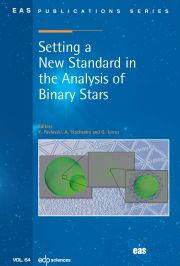Article contents
Thermal evolution of interstellar ice analogues containingformaldehyde
Published online by Cambridge University Press: 13 February 2013
Abstract
We have developed a new laboratory approach to investigate the evolution of interstellarices by separating thermal processing from VUV processing. Infrared spectroscopy and massspectrometry are used to monitor the thermal evolution of ice containing formaldehyde(H2CO) and ammonia (NH3). The main idea is to distinguishphoton-induced chemistry from thermally induced chemistry. We show that H2COand NH3 thermally react at low temperature (40 K) to give aminomethanol(NH2CH2OH). We also show that in presence of HCOOH the warming ofan ice mixture H2CO:NH3 gives at room temperaturehexamethylenetetramine (HMT-C6H12N4). From anastrobiological point of view, HMT is of significant interest, since its hydrolysis leadsto the formation of amino-acids. Furthermore, it is one of the main refractory productsobtained after VUV photolysis at 10 K of ice mixtures containing CH3OH andNH3. It is also suspected to be a part of the organic matter present incomets and asteroids. In this contribution, we demonstrate that HMT can no longer beconsidered as a reliable indicator of VUV photolysis of ice, as we demonstrate that it canbe formed from a purely thermal reaction.
Information
- Type
- Research Article
- Information
- Copyright
- © The Author(s) 2013
References
Références
- 5
- Cited by

